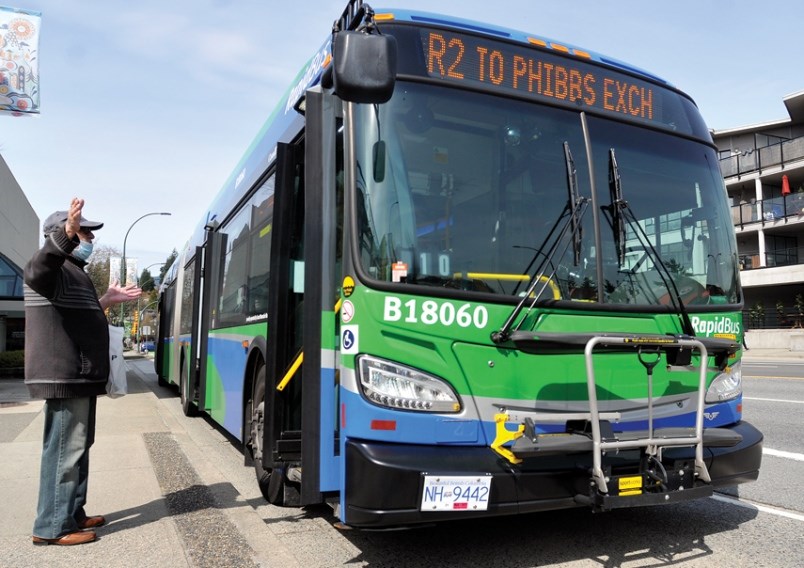It’s the biggest change to the North Shore’s transit landscape in decades but the Marine-Main R2 RapidBus entered service with little fanfare Monday as COVID-19 has kept commuters at home.
“While these are extraordinary times, the launch of RapidBus service on the North Shore is an important milestone,” said TransLink CEO Kevin Desmond.
North Vancouver-Lonsdale NDP MLA Bowinn Ma, who has been an ardent champion for the RapidBus, ran out to greet it as it passed through her Marine Drive neighbourhood Monday, but she had to watch wistfully from the sidewalk
“The Marine-Main R2 RapiBus is, arguably, the most exciting public transit service improvement to the North Shore since the SeaBus,” she said. “I didn't get on to it because I did not have any essential travel to justify getting onto a bus.”
The bus is scheduled to run from Phibbs Exchange to Park Royal and back with service every eight minutes during rush hours - a capacity of 1,650 people per hour, although it won’t be as frequent during the pandemic. TransLink estimates the trip can be done 20 per cent faster than the no- retired 239 route.
“But it isn't just about fewer stops and longer buses. It is also about increasing the reliability, comfort and rapid transit-like nature of buses,” Ma said.
And Ma added, if the R2 is well used, it will bolster the North Shore’s case for even better rapid transit down the line.
“A lot of rapid bus-type lines have turned into fixed-rail rapid transit lines once the communities were able to demonstrate the ability to embrace that kind of transportation strategy,” she said.
According to TransLink, it’s too soon to judge how well the R2 is operating. The same virus that has caused a 90 per cent reduction in transit riders is also keeping the roads free of most traffic.
The quiet launch shouldn’t cloud what is otherwise a big step forward for mobility on the North Shore, said City of North Vancouver Mayor Linda Buchanan.
“We should celebrate that once we resume normal routines, this new rapid transit line will be in place to help move people through our busy corridor faster. This RapidBus line will deliver positive results for the community now, and well into the future,” she said.
Similarly, District of North Vancouver Mayor Mike Little welcomed the faster, more convenient option to get between the North Shore’s three municipalities.
“Implementing this rapid transit option is a crucial step to connect our communities and support our long-term transportation planning goals,” he said.
West Vancouver council’s decision to halt the RapidBus at Park Royal represents a “missed opportunity” for the entire North Shore, Ma said, but she remains hopeful.
“Having an endpoint at Park Royal is certainly better than not having an endpoint into West Vancouver at all. I do suspect that over time, when we get to the other side of this pandemic and ridership on the art two starts to surge, that communities farther west of Park Royal will wish that it went as far as it could,” she said.
As the R2 comes into service, TransLink is making a series of changes to routes on the North Shore. Among them: the new 222 Willingdon Express comes into service, which will connect Phibbs to Metrotown with only four stops in between. The 240 bus will now connect all the way to Lynn Valley. Riders who previously took the 239 all the way to Capilano University will now have to transfer to the 245 at Phibbs Exchange and the 255 will now serve Lower Lonsdale instead of Lynn Valley.
Anyone aboard a bus today is someone working in an essential service and is deserving of our thanks, Ma added.
“We have hundreds and hundreds of bus drivers on the roads every single day providing a very essential service to people and I wish that I was able to be out in public more to be able to thank them,” she said. “Every single person who is working out there on the front lines, whether or not they're in healthcare, or in the grocery store or just trying to move people around - they're doing that so the rest of us can stay home, stay safe and healthy and I'm very, very grateful.”
The bus was originally targeted for the fall of 2019 but the municipalities needed more time to install the RapidBus infrastructure needed to keep it running on schedule including bus rapid transit lanes and queue jumper lanes and new traffic signals that give the buses a head start.
Read more from the North Shore News



